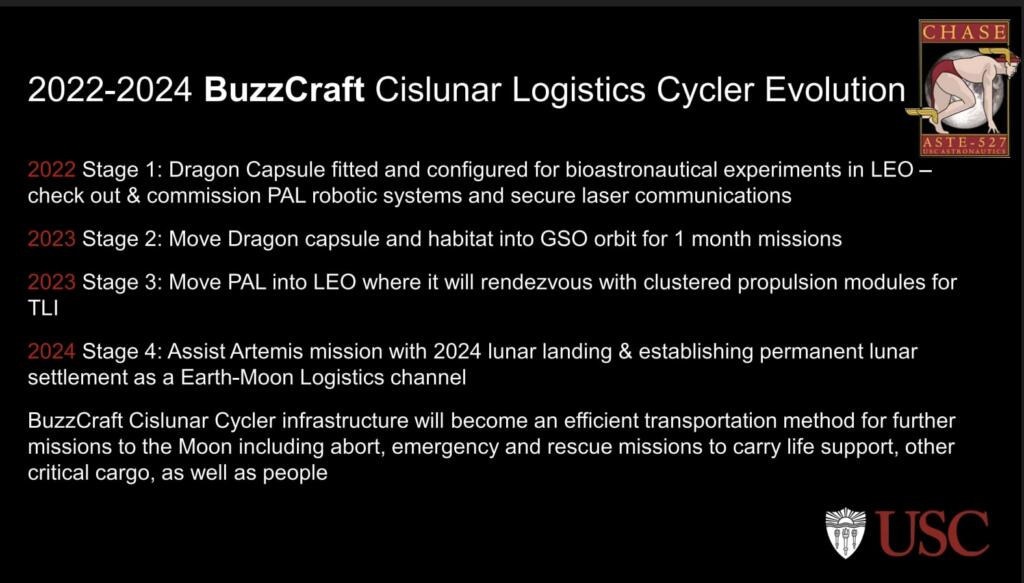A Cislunar Cycler, called Buzzcraft, would continually cycle in an orbit between the Earth and Moon, passing close to both Moon & Earth at regular intervals. Cyclers are among the most efficient cislunar transportation methods. The Buzzcraft concept was developed by Brad Manucha for the USC ASTE 527 course taught by Madhu Thangevalu.
Buzz Aldrin, second man on the moon, has been a propoent of cyclers from Earth to Mars. This is named after Buzz but is a cycler from Earth to the moon designed by Brad Manucha.
Buzzcraft would also require less propellant to fly in this orbital profile for multi-year missions to establish a sturdy Earth-Moon Logistics Channel and provide vital abort, emergency and rescue missions if and when the need arises.
Cycler spacecraft are likely to become a part of the critical interplanetary infrastructure to transport people and cargo.



Brian Wang is a Futurist Thought Leader and a popular Science blogger with 1 million readers per month. His blog Nextbigfuture.com is ranked #1 Science News Blog. It covers many disruptive technology and trends including Space, Robotics, Artificial Intelligence, Medicine, Anti-aging Biotechnology, and Nanotechnology.
Known for identifying cutting edge technologies, he is currently a Co-Founder of a startup and fundraiser for high potential early-stage companies. He is the Head of Research for Allocations for deep technology investments and an Angel Investor at Space Angels.
A frequent speaker at corporations, he has been a TEDx speaker, a Singularity University speaker and guest at numerous interviews for radio and podcasts. He is open to public speaking and advising engagements.


I see no mention of Starship in this scheme, and a central role for Orion. Is this realistic, given NASA’s award of the initial HLS role to Starship, and the dependence of Orion of the “annual” SLS?
Hi Brian
Did they work out the orbital mechanics? There’s a 2008 paper that discusses it – quite the orbit!
https://cbboff.org/UCBoulderCourse/documents/LunarCyclerPaper.pdf
Perhaps the cycler/sardine-craft concept can be augmented by rotovators that boosts the delta-V of the sardines before docking the cycler. As long as everything takes place clear of the atmosphere, it should be predictable. If there is equal traffic up and down to Earth, momentum of a rotovator doesn’t need much maintenance.
This feels like easier than catching boosters and Starships with the Mechazilla chopsticks.
The sardine-craft should probably tag along the cycler once docked and not depart with some retrograde burn. Probably less delta-V to reenter earth during the next cycler approach.
Like I said, you need a transport at both ends of the trip, or you’re stuck on the cycler. Makes sense to use the same transport at both ends, if it has enough delta V. Especially for a short trip like this, it’s not as though you’d have time to do anything else with it while waiting for the cycler to get back.
The Earth-Moon trip seems awfully short to justify a cycler, but I suppose it’s practice. And everybody knows NASA doesn’t do anything in one step if they can break it down into separate steps; They probably even establish a base camp in the parking lot when they send somebody on a snack run.
Repeating a lost comment:
Since even using a cycler, you need the same velocity changes to board and depart as you would for the trip without it, the primary use of a cycler is to provide better accommodations for the trip. Radiation shielding, more space, more comfort, spin gravity, good closed life support; All while permitting the transport vehicle used at each end of the trip to be very bare bones, packed like sardines.
Thus cyclers make much more sense for long trips like that from Earth to Mars, than a 3 day trip like to the Moon.
I suppose you have to start somewhere, though.
It could also be a destination in itself. A large space station within rapid reach of both the Earth and the Moon could be rather valuable. For example in manufacturing, raw materials up from the Moon, processing in microgravity, finished product down to Earth. Until captured asteroids become viable it’s probably the lowest delta-V option for that sort of thing.
I would suggest that it would be very “courageous” * to plan an Earth-Mars cycler (or asteroids, venus, whatever) without doing an Earth-Moon one first.
That’s exactly the sort of thing you want to do on a small, short term, theoretically-possible-to-survive-if-something-goes-wrong**, scale before you go for the real deal.
*In Sir Humphrey Appleby’s sense of the word.
** Not just theoretical, Apollo 13 showed it WAS possible.